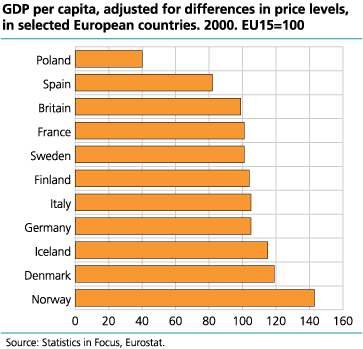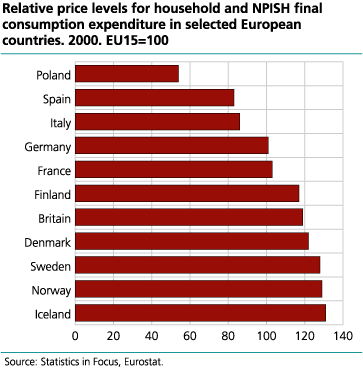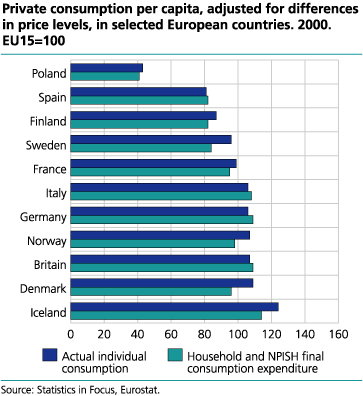Content
Published:
This is an archived release.
Second highest GDP per capita in Europe
Gross domestic product (GDP) per capita in Norway is 43 per cent higher than the EU average, whereas the level of private consumption is more in line with the EU member states when differences in price levels are taken into account. The relative price level in Norway is 29 per cent higher than in the EU as a whole.
Eurostat has recently published preliminary results of the 2000 purchasing power survey. The results cover the 31 countries currently taking part in the European Comparison Programme. Final results for 2000 are due towards the end of the year.
Gross domestic product per capita: Norway in the high-income group
Luxembourg and Norway are the two countries that show the highest GDP per capita adjusted for differences in relative price levels. These two countries are 94 and 43 per cent above the EU15 average, respectively. Some characteristic features of the two economies contribute to explaining these high levels of income: Luxembourg has a considerable number of employees who live in the neighbouring countries and thus contribute to the domestic economy without being part of the resident population. In addition, private individuals' cross-border trade may be of importance. In the case of Norway, oil prices are of great importance. High oil exports and the fact that the price of oil is determined on world markets will tend to make the results for Norway fluctuate with the oil price.
The EFTA countries Iceland, Norway and Switzerland all have a considerably higher GDP per capita adjusted for price level differences than the EU average. Among the Nordic countries, Denmark, Iceland and Norway have a relatively high income level, whereas Finland and Sweden are close to the EU average, like the major EU member states France, Italy, Britain and Germany.
All EU Candidate Countries have a lower GDP per capita than the EU15 average, even when differences in relative price levels are taken into account. However, Cyprus and Slovenia are at about the same level as the EU members Greece and Portugal. The Candidate Countries in Central and Eastern Europe, as well as Turkey, have considerably lower income levels than the EU Member States, but there are large differences within this group of countries. At the general level, it will often be the case that a country with a low (unadjusted) GDP per capita will also show a low relative price level. Adjusting GDP for differences in relative price levels will thus to some extent even out the differences between "rich" and "poor" countries.
Private consumption at EU level
Norway's level of private consumption, adjusted for price level differences between countries, is close to the EU average. It is common to differentiate between two measures of private consumption, i.e. between actual individual consumption and final consumption of households and non-profit institutions serving households (NPISH). Actual individual consumption consists of goods and services purchased directly by private households and non-profit institutions, plus goods and services which are provided by the government but consumed individually, like education and health services. Final household and NPISH consumption consists of just those goods and services that private households and non-profit institutions purchase directly.
Actual individual consumption in Norway is 7 per cent above the EU average. Luxembourg (39 per cent above the EU average), Iceland (24 per cent) and Austria (11 per cent) are at the top of this list. Sweden is somewhat below the EU average, but ahead of Finland and certain EU countries in Southern Europe. In most Candidate Countries, personal consumption pro capita is considerably lower.
The results for final household and NPISH consumption expenditure reveal a somewhat different picture, with Norway slightly below the EU average. Final household consumption is 45 per cent higher than the EU average in Luxembourg, 20 per cent in Switzerland, 14 per cent in Iceland and 12 per cent in Austria. Finland and Sweden are 18 and 16 per cent below the EU average, respectively.
High price levels in the Nordic countries, Britain and Switzerland
The purchasing power parities that are used to adjust for differences in relative price levels can also be used to produce indices for the relative price level of each country. Iceland, Norway, Sweden and Switzerland all have a relative price level for final household and NPISH consumption which is more than 25 per cent higher than the EU average. Denmark, Finland and Britain also stand out with a high price level, whereas Portugal shows the lowest relative price level in the EU. In most of the Candidate Countries, the relative price level is much lower.
Read more about the 2000 results in Eurostat's publication 'Statistics in Focus'
Tables:
This page has been discontinued, see Comparison of price levels in Europe, Annually.
Additional information
Contact
-
Birte Larsen Sandstå
E-mail: birte.sandsta@ssb.no
tel.: (+47) 92 60 56 03
-
Hamdi A. Mohamed
E-mail: hamdi.mohamed@ssb.no
tel.: (+47) 46 81 54 76
-
Norway-ppp@ssb.no
E-mail: norway-ppp@ssb.no



